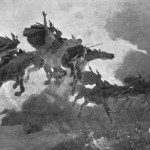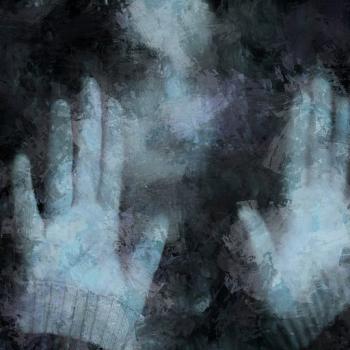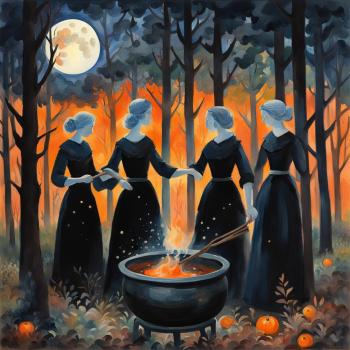“The box was opened, and sure enough the devil’s portrait, by Ma[r]shman, in colours, was found inside, together with a verse of scripture written backwards, and some toads’ legs.“
–Sheffield Daily Telegraph – Saturday 08 November 1856 “WITCHCRAFT.”
At the turn of the century witchcraft and sorcery was as alive and well as it is today. And one of the most compelling forms it takes, is in colored portraits of devils, fairies and spirits drawn by sorcerous women channelling visions.
The colored cards most occultists read their fortunes on today are based upon the Rider Waite Tarot Deck drawn and painted by sorceress artist Pamela Coleman Smith. How alike, I wonder, is her Devil card to the painting of the devil in a box that the unknown artist witch Ruth Marshman made for her magic box?
Smith illustrated the major arcana from detailed notes by Charles Edward Waite, but most likely worked from lists of meanings for the pip cards, that previous to the Rider-Waite deck were usually only pictured with the number of coins, cups, swords or wands. Much of the vibrant imagery of the tarot decks many use today are indebted to her visionary art. As a member of the Golden Dawn, Smith was more than just a hired illustrator, she was educated and aware of the occult principles and symbols she was drawing. Nicknamed, Pixie, Smith was best known for her synesthesiac creations that she painted translating her visions seen while listening to musical pieces onto paintings. Additionally, not unlike politically active witches today, Smith contributed art pieces towards Woman’s Sufferage in Britian. Half Jamacian herself, Smith also wrote and illustrated two books on Jamacian-African folklore. And so her art served a greater purpose beyond the merely aesthetic in both her support of women’s rights and her mediumistic painting.
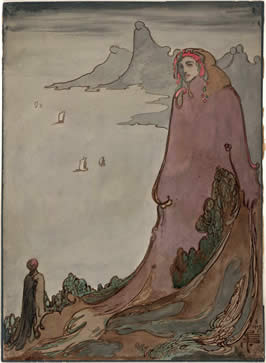
Pictured to the right is Pixie Smith’s synesthetic painting of Beethoven’s Sonata #11. The mountains appear as gods or titans and the pilgrim looks off to the sea at sail boats much like three of wands in the tarot deck. This is repeated imagery for her and suggests that the design for that card was her own visionary experience.
Smith split her time between Jamaica, Brooklyn and Britain. Ships must have been a common sight to her. The longing of having multiple homes, and the wish for rootedness shows in the beauty and intimacy of the mountain family. This speaks to the knowledge of a spiritual home that one can send their soul to in astral art and meditation.
Picture a staunch woman standing before you like a valkyrie with two black wings spread upon her hat, the compelling feminist sorceress artist from the Golden Dawn, Maud Gonne created unique mythical illustrations for her friend Ella Young’s Celtic Wonder Tales. In a similar manner to Pixie Smith, Gonne, turned her magical art towards the political. Ella Young and Maud Gonne were both Irish Nationals and they were passionate about reviving Gaelic and preserving traditional folktales of the Irish peasantry that they treasured. In 1910 Young and Gonne published Celtic Wonder Tales with each story beautiful brought to life by Gonne’s magical images which are rife with not only Celtic imagery but occult meaning much like Smith’s tarot in style and symbolism. Both Smith and Gonne were associates of Yeats and members of the Golden Dawn.
It is key here to note that in augmentation to their spiritual revival of Celtic identity, was the political. Ella Young hid guns for the revolution in her home. Gonne and Young illegally taught Gaelic to school children. Both helped in many ways with revolutionary activity.
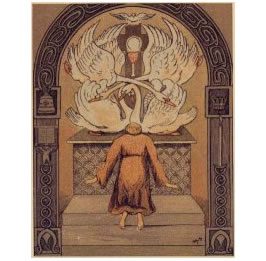
In the image to the right, the inside cover image for Ella Young’s Celtic Wonder Tales, Gonne created a picture outside any scenes in the stories. The picture has some similarities with the ace of cups in the Rider Waite Deck. I believe this is an abstraction of the priest who converted the Children of Lir to Christianity.
Maud Gonne and Ella Young were involved with a Celtic Revival mystic order outside of the Golden Dawn called the Fellowship of the Four Jewels. One of the principals of this order was relating to mountains as gods. This links back to the image above by Pamela Coleman Smith that combines that philosophy with the imagery found also in the tarot.
The image of the devil was empowering for Ruth Marshman’s magic as it was for Coleman, Gonne, and Young’s mysticism, nationalism, and feminism. The drive to rebel, to break the shackles and be reborn is evident in their art, literature, and political activities. When she has found power in magic, she demands power in other life arenas as well. Often there is a wish to date the relevance of sorcer(ess)y, art and feminism to a particular post-modern time period, but examples like the women of the Golden Dawn place that drive fifty years earlier in Modernity.

Patheos Pagan on Facebook.
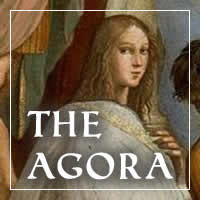
the Agora on Facebook
Star Made Witch is published bi-monthly on alternating Mondays here on the Agora. Subscribe via RSS or e-mail!
Please use the links to the right to keep on top of activities here on the Agora as well as across the entire Patheos Pagan channel.


